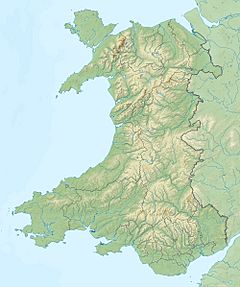Coygan Cave facts for kids
| Location | near Laugharne |
|---|---|
| Region | Carmarthenshire, Wales |
| Coordinates | 51°45′16″N 4°29′12″W / 51.75444°N 4.48667°W |
| History | |
| Material | Karst |
Coygan Cave was a special cave in Carmarthenshire, Wales. It was located near the town of Laugharne. This cave was once full of bones, which is why it's called an "ossiferous" cave.
The cave was found in a limestone hillside, about a mile from the sea. Sadly, the cave no longer exists. It was destroyed because of quarrying, which is when stone is dug out from the ground.
Contents
What Was Found at Coygan Cave?
Even though no human bones were found inside Coygan Cave, many interesting tools were discovered. These tools were handaxes, which are ancient stone tools shaped like an axe.
Who Might Have Used the Cave?
Archaeologists found three special triangular handaxes. These tools are called bout coupé handaxes. They suggest that Neanderthals might have used the cave. Neanderthals were an ancient type of human. They may have been there between 64,000 and 38,000 years Before Common Era (BCE). This means they were there a very, very long time ago! The handaxes were made from materials found nearby.
Animal Residents of the Cave
After the Neanderthals, Coygan Cave became a home for hyenas. These animals used the cave as a den. A famous zoologist named George Rolleston studied the cave. He said it was "the most perfect instance of a hyena den" he had ever seen. He made this observation before he passed away in 1881.
Discovering the Past
Many of the animal bones from the cave were collected by Rev G N Smith. He was a person who wrote letters to the famous scientist Charles Darwin. Today, you can see some of the amazing finds from Coygan Cave. They are kept at the National Museum of Wales. Other discoveries are at the Carmarthenshire County Museum. These museums help us learn about the ancient past of Wales.



